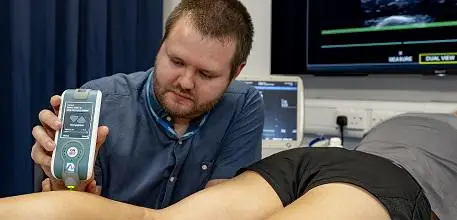Muscle monitoring space tech could help hospital patients
Southampton researchers are investigating if a handheld device used to track astronauts’ muscle health could soon also benefit patients.
The technology provides an easy-to-use way of measuring muscle health.
It could help inform the treatment of patients with conditions like sarcopenia, Parkinson’s disease or stroke.
Muscle loss in space
The MyotonPRO is a smartphone-sized device which measures the properties of muscles. It works through a ‘tap and listen’ or 'Mechanical Dynamic Response' method. This involves applying a gentle mechanical impulse to the muscle and measuring how the tissue responds. This is used to estimate the muscle’s stiffness.
Researchers used the device to monitor the muscle health of astronauts before, during and after a few months on the International Space Station (ISS). The international team on the Myotones project was led by Prof Dieter Blottner at Charité University in Berlin and researchers from the University of Southampton funded by a grant from the UK Space Agency were Prof Maria Stokes, Dr Martin Warner and Paul Muckelt.
Microgravity conditions in spaceflight mean astronauts’ bodies aren’t subjected to the workload they are used to on Earth. This means their muscles don’t have to work very hard to perform tasks onboard the spacecraft. This puts astronauts at risk of muscle weakness and bone loss, with up to a 20 percent decrease in skeletal muscle mass over a month.
To counteract this, astronauts onboard the ISS perform an exercise programme for around two hours a day, six or seven days a week. Until now, monitoring the effectiveness of this programme has only been possible with pre- and post-flight checks. This was due to a lack of appropriate equipment.
Findings published in Nature Scientific Reports show the astronauts’ exercise regime was effective in preserving most muscle groups. However, crucial lower leg muscles showed signs of deterioration.

Checking patients’ muscle health
Paul Muckelt was the UK Research Fellow on the Myotones project and is a PhD student at the University of Southampton. He undertook a large proportion of the data collection for the research into astronauts’ muscle health.
Now he’s looking at how Myoton technology can complement assessment of patients in hospitals and also understand mechanisms of dysfunction to develop treatments, as part of his role at the NIHR Southampton Biomedical Research Centre (BRC). His work sits within the Centre's Perioperative and Critical Care theme, in a team led by Prof Peter Worsley.
“Because it’s a relatively small, easy-to-use technology,” Paul explains, “it could be used by different healthcare professionals in a hospital to monitor patients at different stages of their treatment.”
In particular, his new team are interested in whether the device could be used to check hospital patients for sarcopenia. Sarcopenia is a loss of muscle mass and strength associated with ageing. It is a common cause of frailty, fractures and falls in later life.
People with sarcopenia take longer to recover from surgery. Extended periods of inactivity such as bed rest in hospital can also accelerate the condition. An objective test for sarcopenia could therefore help inform decisions around their treatment.
The Southampton team have conducted several studies to ensure use of Myoton technology is accurate and reliable, including the protocol used for the astronaut study. In collaboration with clinical physiotherapists and researchers in Ghana, the Southampton team have also published research in the Ghana Medical Journal. That study showed that it is possible to use the MyotonPRO to measure muscle stiffness reliably in people with Parkinson’s disease.
‘Revolutionise healthcare’
Studies of astronauts in space provide a useful model for what happens on Earth when muscles become weak due to ageing or not being used. This could be due to injury, joint diseases or neuromuscular disorders. The Southampton team is very well placed for translating their research directly from space to studying sarcopenia in the BRC.
Prof Stokes and Dr Warner are also part of the Perioperative and Critical Care team at the BRC.
Dr Warner, Associate Professor at the University of Southampton and co-senior author on the astronaut study paper, said:
“This technology and the use of passive muscle stiffness as a muscle health indicator could be used by many health professionals during clinical assessments. Widespread uptake could revolutionise healthcare in neuro-musculoskeletal, critical care and geriatric medicine, rehabilitation and precision medicine.”
Prof Stokes, Professor of Neuromusculoskeletal Rehabilitation at the University of Southampton, said:
“As with any novel technology, however accurate it might be, it needs to be practical for using in a clinical environment. The fact that using the MyotonPRO device could fit into astronauts’ busy schedules is very promising for use with patients on wards or in outpatient clinics. It takes less than 30 seconds to get a recording and the results appear immediately on the screen of the device or can be downloaded to a computer.”
Top right image: NASA astronaut using the Advanced Resistive Exercise Device (ARED) onboard the ISS (credit: NASA)
Lower image: Paul Muckelt using the MyotonPRO device (credit: Institute for Life Sciences)